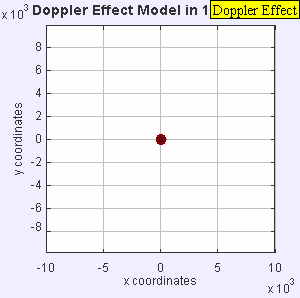- Mach number is the
source velocity v in units
of the sound speed v_ph
(i.e., phase velocity)
of the medium.
Thus Mach number = v/v_ph.
- The sound waves
from point source are
spherical waves with
respect to the medium.
The spherical waves in the animations are seen in cross section.
The squeezing/stretching of the wavelength relative to the Mach = 0 case show the degree of Doppler effect: i.e., blueshift/redshift of the wavelength from the REFERENCE wavelength.
When the waves are squeezed to merging you have a shock wave that is heard as a sonic boom. A sonic boom is a very strong constructive interference.
The merging happens for transonic (speed of sound) motion by the source and supersonic motion by the source.
- Our ideal source does NOT give exactly the behavior of a
jet aircraft, but
it mimics it for our explanatory purposes.
Now a real jet creates series of sound waves (i.e., pressure waves) as it propagates that travel outward in all directions. The source of the sound waves are probably all kinds of vibrations associated with the jet motion and their frequencies probably do depend on jet speed.
- Quick description of the animations:
- Figure 1: Mach = 0.
The source is unmoving in the
medium.
There is NO Doppler shift
for any observer.
- Figure 2: Mach = 0.7.
The source is subsonic,
and so the source does NOT outrun the
waves in any direction.
- Figure 3: Mach = 1.0.
The source is
transonic,
and so keeps keeps up with the
waves emitted in the forward
direction.
These forward waves pile up on each other and merge into
a shock wave.
The shock wave
would build up to infinite
amplitude
if dissipation processes
didn't keep turning
sound energy
into waste heat.
The shock wave gives
a sonic boom.
Only observers close to path of the source (i.e.,
at small impact parameter)
would get the full
sonic boom.
- Figure 4: Mach = 1.4.
The source is
supersonic,
and so outruns the waves
in the forward direction and leaves a trail of expanding
spherical waves
in its wake.
The spherical waves
in a special direction relative to the moving source merge into a
Mach cone
which is the locus
of a
shock wave
and the concomintant
sonic boom.
The Mach cone trails the moving source and is centered on its trajectory with opening angle (i.e., apex angle) θ.
- Figure 1: Mach = 0.
The source is unmoving in the
medium.
There is NO Doppler shift
for any observer.
- There is a simple explanation for the
Mach cone
and a formula for
opening angle θ.
However, we will NOT gives those here.
- The classical Doppler effect
formulae
are derived and somewhat explicated in
Waves file:
doppler_effect_classical_derivation.html.
- See also Doppler effect videos below (local link / general link: doppler_effect_videos.html):
- Image link: Wikimedia Commons:
File:Dopplereffectstationary.gif.
- Image link: Wikimedia Commons:
File:Dopplereffectsourcemovingrightatmach0.7.gif.
- Image link: Wikimedia Commons:
File:Dopplereffectsourcemovingrightatmach1.0.gif.
- Image link: Wikimedia Commons:
File:Dopplereffectsourcemovingrightatmach1.4.gif.




Caption: Animations illustrating dynamically the sound waves and Doppler effect (i.e., the classical Doppler effect) for an ideal point source of sound that produces an isotropic continuous stream of wave cycles at a fixed frequency in its own reference frame.
The REFERENCE wavelength is the wavelength this source would give when it is at rest in the propagation medium for the sound waves.
In the animations, the source is moving with a range of velocities (Mach 0, Mach 0.7, Mach 1.0, Mach 1.4) with respect to the medium.
Features:
-
Images:
File: Waves file: doppler_effect_sonic.html.